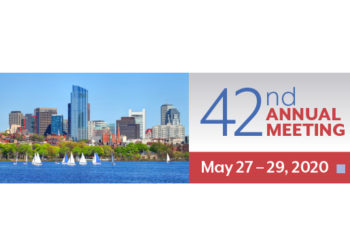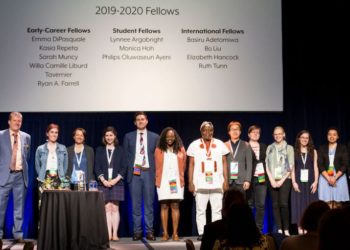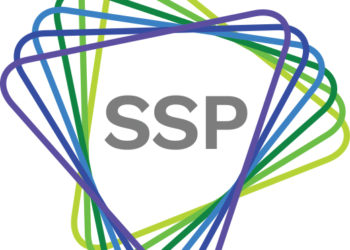The Society for Scholarly Publishing’s (SSP’s) 43rd Annual Meeting will take place May 24-27, 2021 with a range of educational sessions, keynote speakers, networking opportunities, and more. To offer a glimpse behind the curtain on the planning for the meeting, Stephanie Lovegrove Hansen (Senior Marketing Manager at Silverchair and SSP Marketing Committee liaison to the Annual Meeting Program Committee), sat down with the APMC co-chairs, Lori Carlin (Chief Commercial Officer & Senior Consultant at DeltaThink), Yael Fitzpatrick (Editorial Ethics Manager at the Proceedings of the National Academy of Sciences), and Cason Lynley (Director of Marketing, Sales, & Finance at Duke University Press).
Watch the full interview or read an excerpt below.
Stephanie Lovegrove Hansen (SLH): I know everyone in our industry (and every industry) has been working on how to shift to virtual and how to maintain the things that make each meeting unique. What have you found to be the biggest challenge in making the shift to virtual?
Lori Carlin (LC): We are very much a team, but we do have certain remits, and mine is to focus primarily on the pre-meeting sessions. Keeping attendees engaged during sessions is especially important during those pre-meeting sessions, because they’re training sessions this year. So we’re targeting people who are earlier in their career and providing them with a lot of information over the course of several days. We always like to have interactivity with the annual meeting sessions, whether in person or online. But it’s even more important with these training sessions and for these folks who are newer to the industry, because there’s just so much information that’s going to be coming at them. We want to make sure that they stay engaged, and especially in a virtual environment, that can be a little bit more challenging.
Yael Fitzpatrick (YF): I would say that one of the biggest challenges that we’ve been addressing with the shift to virtual is making up for the loss of in-person networking. I think that a lot of people in the SSP community, and the publishing community as a whole, really enjoy that part of the meeting when it’s in person. People are really longing for that interconnectivity, and for those serendipitous meetings where you just walk down the hallway and say, “oh, hey, I haven’t seen you for a year, or two, or ten!” And so, while realizing that we can’t recreate that, we’ve been exploring ways of creating possibilities to adequately replace that in some way.
Cason Lynley (CL): To add to that, one of the things we did this year for the first time is that we had two subcommittees: one that was focused on virtual first and how to approach that, and a second subcommittee on networking and how to approach it from the virtual perspective. And, as Yael said, we’ve worked on not trying to replace what happens in person, but rather trying to find ways to have people connect in more personal or even one-on-one opportunities throughout the conference.
SLH: I like that you’re thinking about networking from a virtual-first perspective. I think that last year, everyone was looking to take what they had already planned as an in-person meeting and shift it to virtual. Whereas this year, starting from virtual, we have the opportunity to really take advantage of some virtual best practices and make sure that the format and the content go hand-in-hand a little better. And so from that perspective, what has been the biggest opportunity in shifting to virtual?
YF: Something that we’re considering a really great opportunity from the shift to virtual is that we have started a new initiative. This was an idea that came from the networking subcommittee, which was to form what we’re calling “conference community groups.” It’s the first year we’ve done something like this, and it’s an attempt to give people a professional family of sorts to attend the meeting with, so that people don’t feel isolated when everybody is staring at a screen from their own home or office. So attendees have the opportunity to opt into these conference community groups. They’re going to be small groups of up to about six people, with a mix of first-time attendees and longtime veterans, people from different sectors of the industry, and people from different career paths. We’re establishing some touchpoints where people can meet up virtually throughout the meeting to just touch base, check in with one another, exchange thoughts or ideas that they’re having about the meeting, and hopefully feel a little bit more connected.
CL: I think the other big opportunity is expanded reach. We’re hoping that more people will be able to attend since there isn’t the expense of travel.
LC: Absolutely, that’s one of the things that we think is a big benefit of the virtual setting. And when it comes to the pre-meeting sessions, these were set up to encourage organizations to send their more junior staff, maybe folks that didn’t normally go to an annual meeting. You can send folks, now, to the annual meeting for a day. They can get training. They can meet some folks. And whereas it used to be very localized to people who could get in their car, or get on a train, or a bus and go for that one day and not have that travel expense, now we have an opportunity to open it up really broadly. Not only within the United States, but globally for anyone who wants to get training on the journals or the books area of the business.
SLH: You’re right, that’s a huge opportunity. That’s something we’ve seen in our own events. It’s no longer restricted by organizational budgets, or by family obligations, or other things that might prevent you from traveling. Anyone can attend these kinds of events, which really makes it exciting. You get a whole different kind of audience attending. As such, that might bring some people that haven’t been attending the meeting historically. So what tip would you give attendees to make sure that they get the most out of their attendance?
CL: I would go back to the conference community groups. We’re really excited about those. Especially as a first-time attendee, it can seem really overwhelming because there’s so much information and so many people that trying to find your feet can be hard. I hope that people will take the opportunity to sign up for these groups because I think it will help tremendously, not only for the first-time attendees, but also as an opportunity for people who are regular attendees to get to know a smaller group of people better throughout the conference.
LC: I think that when we’re physically at a conference, we take our mind out of the office, and we can really concentrate on being at the conference. We spend a little time going through the program and deciding what sessions we want to go to. It’s easier to not do that when you’re in a virtual environment. To just show up and say, okay, I’ll go to this. So I would recommend taking that time to look at the schedule, think about what you’re going to learn, and maybe think in advance of some questions you may have, because you have an opportunity to be talking to experts in the field.
YF: I would also encourage people to embrace what is afforded by the different platforms that we’re using for this meeting. With this being the first year that we are doing a fully virtual meeting, we have two main platforms. We have the Pathable platform that we’re using for the meeting content, and then the Remo platform that we’re using more specifically for networking. We’re excited about the fantastic opportunities that both of these technologies afford. I realize that it can be overwhelming for people. We’re asking people to juggle a lot. But I think that if people are willing to just dive in and embrace it, it will really lead to a great experience.
We hope to see you at the 2021 SSP Annual Meeting, starting on Monday! Learn more and register here.
Discussion
2 Thoughts on "The 2021 SSP Annual Meeting: What’s New, What’s Different, and How to Get the Most Out of Attending"
It is a big job to transition a conference as big and busy as the SSP Annual Meeting to its first ever all-virtual edition, but reading this post has me really excited for next week. Having sat on the program committee this year I have seen how much time and thought the organizers have put into all of the little details to make sure there is something for everyone. (In fact there are some things I hope we keep for next year when we are back to some degree of in person.) Kudos to Cason, Yael, and Lori, and thank you Stephanie for the interview – looking forward to SSP 43!
Thank you so much for the kind words, Laura Ricci! Thank you for your support as our board liaison throughout the year as well as going above and beyond by serving on the networking subcommittee. SSP staff also deserve a big shout out for all the work that they do behind the scene. Not to mention that they are wonderful to work with! And the program committee has been so fantastic with developing new ideas for the virtual first meeting.



